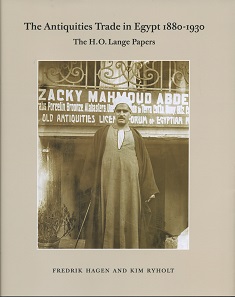by Ursula Kampmann
translated by Christina Schlögl
March 16, 2017 – You know the concept: There are the good people on one side. They are the poor, exploited local population of the Mediterranean countries, whose cultural heritage is taken away by the imperialists. And there are the bad people, the dealers and collectors, whose greed for objects make the imperialists’ thefts profitable. We had to listen to this all too often and we could not disagree, because we did not know how antiquities trade, for instance in Egypt in the 1930s, worked. Now, Fredrik Hagen and Kim Ryholt reconstruct the details on account of a diary of a Danish Egyptologist who traveled to Egypt in 1899/1900 and 1929/30 in order to collect exhibition objects for Danish museums. The authors have not stopped at this diary, though. They have adduced a number of sources to draw a detailed image of the practical workings of the Egyptian antiquities trade.
Frederik Hagen, Kim Ryholt, The Antiquities Trade in Egypt 1880-1930. The H. O. Lange Papers. The Royal Danish Academy of Sciences and Letters. Scientia Danica. Series H. Humanistica 4, Vol. 8, 2016. 335 p. with images in black-and-white and colour. Paperback. 21.2 x 26.5 cm. ISBN: 978-87-7304-400-1. DKK 300 (ca. Euro 40).
Let’s state this fact first: Every tourist bought some kind of antique object as a souvenir. This was virtually expected. Or, as a contemporary travel writer phrased it: “A traveller who has visited Egypt cannot show his face in Europe without a mummy in one hand and a crocodile in the other.” Many established antiquities dealers all over Egypt supplied this demand. And they were not the only ones. Everyone made profit: natives, foreigners, small street venders and the upper class society. An anonymous consul in Luxor for instance, invited rich foreigners to his home every evening and served them an Arabian-style dinner. At some point during dessert, locals would ring the doorbell and show the consul what had been found that day. The consul regularly granted his wealthy guest preemptive right – after all the whole performance had been planned out by him. The antique objects belonged to him and no rich tourist will have resisted this offer (or doubted the price).
One might be surprised to learn that apparently – and Baedeker explicitly points this out to his readers – there was a shop in room XCI at the exit of the Egyptian Museum, where one could buy antiquities whose authenticity was guaranteed by the museum curators. When export permissions became mandatory in 1912, customers even got the permission together with the purchase. The state of Egypt made wonderful profit with these export licenses. They were added to the selling price like a kind of added value tax. All sorts of antiquities were offered in this shop: papyri, scarabaei, ushabtis, coins, bronze figurines, mummies, coffins, larger sculptures and complete burial equipments including wall paintings. We even know the prices, at least for the year 1894: For 20 to 30 pounds, one could purchase a mummy, coffin included. For 5 to 20 pence, one would get a scarabaeus. Incidentally, the shop was not particularly successful. Between 1899 and 1910 it only made 15,866 pounds, slightly more than what it took in museum tickets (10,000 pounds).
Cairo was the most important, Luxor the second most important centre for antique objects. There were also several smaller centres. In 1928, there were sixteen prominent antiquity dealers in Cairo alone, which Baedeker deemed important enough to mention. From photographs we know what these shops looked like on the inside. They show that some of these shops were still active up to the 1970ies.
Naturally, there was illegal trade. Who could imagine any business on earth without a few bad apples? But it is actually baffling to read that all sorts of traders and collectors could obtain an excavation license fully legally. This prerogative was by no means limited to institutions. There was only one condition: Half of the objects went directly to the Egyptian Museum, although the Egyptian government really did not bother with a systematic division of the objects. But as soon as a representative of the government had taken what he wanted, the excavator could do what he wanted with his share. In other words: Nefertiti could very well have been dug up in an excavation that was not carried out by the German Oriental Society, but by some random Egyptian antiquities dealer.
Not only do the authors elaborate on the legal aspect of the antiquities trade, but they also dedicate an extensive chapter to the forgeries. They describe the hunt for papyri and they have compiled a comprehensive index of all Egyptian antiquities dealers known by name.
Thanks to their enormous effort, we now have a much clearer picture on how it was possible for so many Egyptian objects to make their way into occidental collections completely legally. Whether Egyptian institutions will still find it easy to make arbitrary and unjustified restitution claims, remains to be seen.
You can order the book from the Royal Danish Academy of Sciences and Letters.
Please write them an email.





